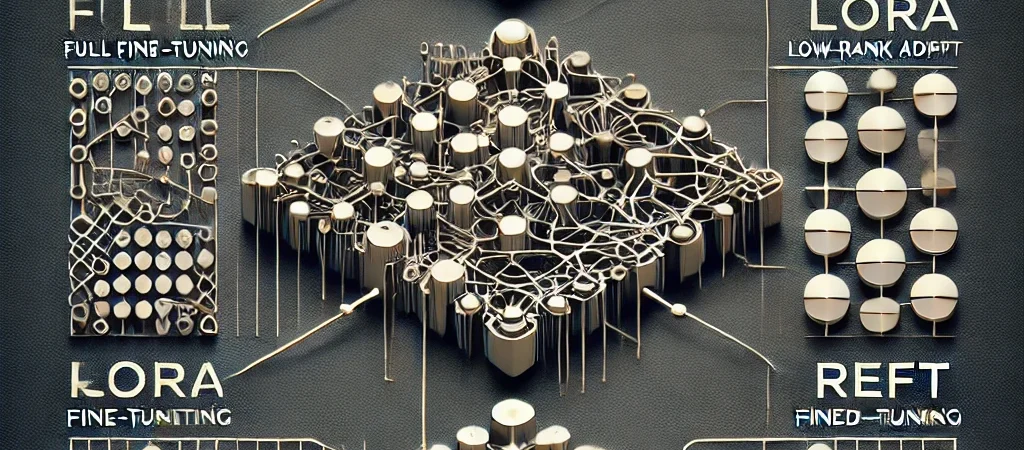Fine-tuning is a critical step in adapting pre-trained models to specific tasks. In this article, I’ll compare full fine-tuning with advanced techniques such as LoRA and ReFT. I’ll highlight the differences in methodology, efficiency, and performance to help you choose the best approach for your projects.
1. Full Fine-Tuning
Full fine-tuning involves updating all model parameters using task-specific data. This traditional approach can deliver excellent performance but comes with significant challenges.
Imagine you have a pre-trained language model like GPT-3, and you want it to generate legal documents. With full fine-tuning, you would retrain the entire model using a large dataset of legal texts. This would require significant computational resources but would tailor the model to produce highly accurate legal outputs.
| Pros | Cons |
|---|---|
| – High task performance. – Full fine-tuning works directly with the existing model architecture without adding any new layers or components, making it straightforward to implement. | – Computationally expensive. – Requires large amounts of data. – Since all model parameters are updated during fine-tuning, there’s a risk of overfitting to the task-specific dataset, particularly if the dataset is small or not diverse. – Time-consuming. |
Full fine-tuning is suitable when you have abundant computational resources and a large dataset. However, its inefficiency and risk of overfitting make it less ideal for many real-world scenarios.
Check out this tutorial to learn more about full fine-tuning.
2. LoRA (Low-Rank Adaptation)
PERT is a family of techniques designed to reduce the computational cost of fine-tuning by updating only a small subset of parameters rather than the entire model. One notable PERT technique is LoRA (Low-Rank Adaptation).
LoRA introduces low-rank matrices to adapt pre-trained model weights, making fine-tuning efficient and adaptable to different tasks. Suppose you’re working on a multilingual translation model. Instead of retraining the entire model for each new language, you can use LoRA to fine-tune low-rank matrices specific to each language. This allows for quick adaptation without extensive retraining.
| Pros | Cons |
|---|---|
| – Efficient use of computational resources. – Faster training time compared to full fine-tuning. – Reduces the risk of overfitting. | – May require additional hyperparameter tuning. – Performance might be slightly lower than full fine-tuning in some cases. |
LoRA and other PERT techniques are particularly useful in resource-constrained environments where fine-tuning the entire model is impractical.
Check out this tutorial to start exploring LoRA and other PERT techniques.
3. Fine-Tuning with ReFT (Residual Efficient Fine-Tuning)
ReFT introduces residual connections during fine-tuning to improve convergence and stability. Unlike LoRA and other PERT techniques, ReFT targets representations in the model instead of directly modifying weights, and it selectively intervenes at certain timesteps rather than applying changes uniformly across all inputs.
Imagine you are fine-tuning a large model like GPT-4 for scientific research paper summarization. ReFT can help maintain the model’s performance on general language tasks while improving its ability to handle scientific jargon, reducing the risk of catastrophic forgetting.
How is ReFT Different?
Many parameter-efficient fine-tuning techniques, such as LoRA, operate on weights. LoRA modifies the output projection matrix in transformers, essentially injecting additional learnable parameters into the attention mechanism. While these methods adjust weights uniformly across all timesteps, ReFT takes a different approach:
- Selective Timesteps: ReFT chooses specific timesteps to apply interventions instead of modifying all timesteps equally. This targeted intervention can reduce unnecessary adjustments and improve task-specific performance.
- Representation-Focused: Rather than modifying weights, ReFT intervenes directly on the hidden representations (i.e., the outputs of intermediate layers). This approach makes ReFT more dynamic and adaptable to different tasks.
For example, consider a task where the model needs to identify and summarize important sentences in a legal document. Traditional fine-tuning techniques (like LoRA) would apply adjustments uniformly across all sentences, regardless of their importance. In contrast, ReFT can selectively apply interventions only to the sentences deemed important by the model. This allows for more efficient and precise fine-tuning.
| Pros | Cons |
|---|---|
| – Improves training stability. – Reduces risk of catastrophic forgetting. – Efficient for large models. | – Slightly more complex architecture, since ReFT involves adding residual adapters or additional layers to the existing model architecture. – Residual adapters in ReFT need to be carefully tuned to ensure that they effectively capture task-specific patterns without disrupting the model’s pre-trained capabilities. This involves selecting appropriate hyperparameters, such as the size of the adapters and their integration points within the model. |
When compared, ReFT has demonstrated that it can be more efficient than prior state-of-the-art PEFT techniques. Learn more about it here.
Also, check out this tutorial to start exploring ReFT.
Conclusion
Each fine-tuning method has its strengths and weaknesses.
| Technique | Parameter Updates | Target | Intervention Scope | Computational Cost | Stability | Risk of Overfitting | Use Case |
|---|---|---|---|---|---|---|---|
| Full Fine-Tuning | All | Weights | All Timesteps | High | Medium | High | High-resource environments |
| LoRA | Low-Rank Matrices | Weights | All Timesteps | Low | Medium | Low | Multi-task fine-tuning |
| ReFT | Residual Adapters | Representations | Selective Timesteps | Medium | High | Low | Large models, stability-focused |
Full fine-tuning delivers strong performance but at a high computational cost. LoRA provides a modular solution, particularly effective for multi-task scenarios. ReFT improves stability and reduces the risk of catastrophic forgetting by focusing on hidden representations and applying targeted interventions at specific timesteps.
Selecting the right technique depends on your specific requirements, including available resources, model size, and target performance.
